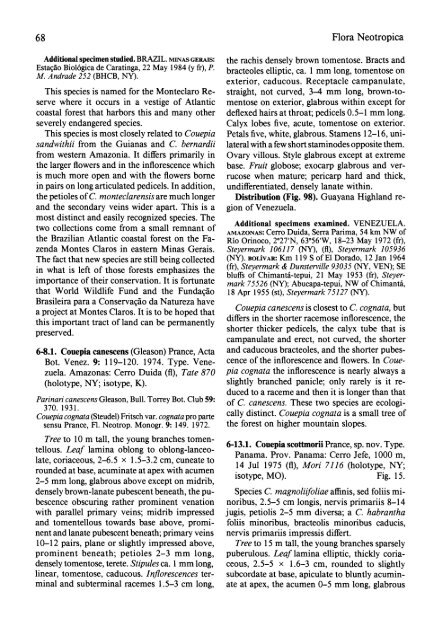flora neotropica - CNCFlora
flora neotropica - CNCFlora
flora neotropica - CNCFlora
Create successful ePaper yourself
Turn your PDF publications into a flip-book with our unique Google optimized e-Paper software.
68 Flora Neotropica<br />
Additional specimen studied. BRAZIL. MINAS GERAIS:<br />
Estacao Biol6gica de Caratinga, 22 May 1984 (y fr), P.<br />
M. Andrade 252 (BHCB, NY).<br />
This species is named for the Monteclaro Reserve<br />
where it occurs in a vestige of Atlantic<br />
coastal forest that harbors this and many other<br />
severely endangered species.<br />
This species is most closely related to Couepia<br />
sandwithii from the Guianas and C. bernardii<br />
from western Amazonia. It differs primarily in<br />
the larger flowers and in the inflorescence which<br />
is much more open and with the flowers borne<br />
in pairs on long articulated pedicels. In addition,<br />
the petioles of C. monteclarensis are much longer<br />
and the secondary veins wider apart. This is a<br />
most distinct and easily recognized species. The<br />
two collections come from a small remnant of<br />
the Brazilian Atlantic coastal forest on the Fazenda<br />
Montes Claros in eastern Minas Gerais.<br />
The fact that new species are still being collected<br />
in what is left of those forests emphasizes the<br />
importance of their conservation. It is fortunate<br />
that World Wildlife Fund and the Fundaqao<br />
Brasileira para a Conservaqao da Natureza have<br />
a project at Montes Claros. It is to be hoped that<br />
this important tract of land can be permanently<br />
preserved.<br />
6-8.1. Couepia canescens (Gleason) Prance, Acta<br />
Bot. Venez. 9: 119-120. 1974. Type. Vene-<br />
zuela. Amazonas: Cerro Duida (fl), Tate 870<br />
(holotype, NY; isotype, K).<br />
Parinari canescens Gleason, Bull. Torrey Bot. Club 59:<br />
370. 1931.<br />
Couepia cognata (Steudel) Fritsch var. cognata pro parte<br />
sensu Prance, Fl. Neotrop. Monogr. 9: 149. 1972.<br />
Tree to 10 m tall, the young branches tomentellous.<br />
Leaf lamina oblong to oblong-lanceolate,<br />
coriaceous, 2-6.5 x 1.5-3.2 cm, cuneate to<br />
rounded at base, acuminate at apex with acumen<br />
2-5 mm long, glabrous above except on midrib,<br />
densely brown-lanate pubescent beneath, the pubescence<br />
obscuring rather prominent venation<br />
with parallel primary veins; midrib impressed<br />
and tomentellous towards base above, prominent<br />
and lanate pubescent beneath; primary veins<br />
10-12 pairs, plane or slightly impressed above,<br />
prominent beneath; petioles 2-3 mm long,<br />
densely tomentose, terete. Stipules ca. 1 mm long,<br />
linear, tomentose, caducous. Inflorescences terminal<br />
and subterminal racemes 1.5-3 cm long,<br />
the rachis densely brown tomentose. Bracts and<br />
bracteoles elliptic, ca. 1 mm long, tomentose on<br />
exterior, caducous. Receptacle campanulate,<br />
straight, not curved, 3-4 mm long, brown-to-<br />
mentose on exterior, glabrous within except for<br />
deflexed hairs at throat; pedicels 0.5-1 mm long.<br />
Calyx lobes five, acute, tomentose on exterior.<br />
Petals five, white, glabrous. Stamens 12-16, uni-<br />
lateral with a few short staminodes opposite them.<br />
Ovary villous. Style glabrous except at extreme<br />
base. Fruit globose; exocarp glabrous and ver-<br />
rucose when mature; pericarp hard and thick,<br />
undifferentiated, densely lanate within.<br />
Distribution (Fig. 98). Guayana Highland region<br />
of Venezuela.<br />
Additional specimens examined. VENEZUELA.<br />
AMAZONAS: Cerro Duida, Serra Parima, 54 km NW of<br />
Rio Orinoco, 2?27'N, 63?56'W, 18-23 May 1972 (fr),<br />
Steyermark 106117 (NY), (fl), Steyermark 105936<br />
(NY). BOLIVAR: Km 119 S of El Dorado, 12 Jan 1964<br />
(fr), Steyermark & Dunsterville 93035 (NY, VEN); SE<br />
bluffs of Chimanta-tepui, 21 May 1953 (fr), Steyermark<br />
75526 (NY); Abucapa-tepui, NW of Chimanta,<br />
18 Apr 1955 (st), Steyermark 75127 (NY).<br />
Couepia canescens is closest to C. cognata, but<br />
differs in the shorter racemose inflorescence, the<br />
shorter thicker pedicels, the calyx tube that is<br />
campanulate and erect, not curved, the shorter<br />
and caducous bracteoles, and the shorter pubescence<br />
of the inflorescence and flowers. In Couepia<br />
cognata the inflorescence is nearly always a<br />
slightly branched panicle; only rarely is it reduced<br />
to a raceme and then it is longer than that<br />
of C. canescens. These two species are ecologically<br />
distinct. Couepia cognata is a small tree of<br />
the forest on higher mountain slopes.<br />
6-13.1. Couepia scottmorii Prance, sp. nov. Type.<br />
Panama. Prov. Panama: Cerro Jefe, 1000 m,<br />
14 Jul 1975 (fl), Mori 7116 (holotype, NY;<br />
isotype, MO). Fig. 15.<br />
Species C. magnoliifoliae affinis, sed foliis mi-<br />
noribus, 2.5-5 cm longis, nervis primariis 8-14<br />
jugis, petiolis 2-5 mm diversa; a C. habrantha<br />
foliis minoribus, bracteolis minoribus caducis,<br />
nervis primariis impressis differt.<br />
Tree to 15 m tall, the young branches sparsely<br />
puberulous. Leaf lamina elliptic, thickly coria-<br />
ceous, 2.5-5 x 1.6-3 cm, rounded to slightly<br />
subcordate at base, apiculate to bluntly acumin-<br />
ate at apex, the acumen 0-5 mm long, glabrous

















